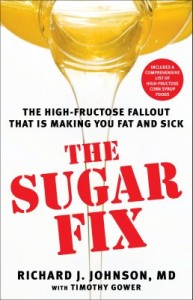In case you think table sugar is safer than high fructose corn syrup, and juice is better that soda . . .
Here’s a recent interview with Dr. Richard Johnson, research professor in the Department of Medicine at the University of Colorado, and author of The Sugar Fix.
Richard Johnson, do you really think sugar may be killing us?
The phrase sugar is killing you is kind of an intense statement. I don’t know that I would say that. But I do think we can say that excessive intake of sugar may be involved in this big epidemic of obesity and diabetes that we’re seeing.
Are you concerned about every kind of sugar or one special kind?
What we’re really concerned about is fructose. It’s a monosaccharide, or a simple sugar.Fructose is present, though, in two major sweeteners that are currently available. One is sucrose, or table sugar, and table sugar consists of one molecule of fructose and one molecule of glucose bound together, in what is called a disaccharide. And then there’s high fructose corn syrup which is usually 55% fructose and 45% glucose.
High fructose corn syrup is in everything.
It’s not in everything, but it’s in a lot of things. It’s amazing if you walk down a grocery aisle, and actually look at the products, how commonly high fructose corn syrup is present. Because it’s a liquid and it can be mixed at small concentrations easily, and it has a long shelf life, and it has the ability to sweeten food just a little bit, so it’s more attractive to the taste.
Fructose is also in apples. It’s in oranges.
Yes, fructose is the main sugar in fruit. And as the fruit ripens that’s what makes the fructose content go up. That’s what makes the fruit sweet and so good to taste. But fruit also has a lot of good things. Fruits have a lot of anti-oxidants, Vitamin C, resveratrol, flavonols, quercetin. They have fiber. They have potassium. They have a lot of things that help neutralize the effects of fructose. Plus, there isn’t that much fructose in a fruit compared to a soft drink . . . maybe one third. Natural fruits are actually fairly safe, and they actually are nutritious and quite good.
But it is true that fruit juices can contain a lot of fructose, and you can drink it very fast, so you can get high concentrations in your blood and in your liver, and that they may be not so good. Studies particularly in children have suggested that fruit juice may increase the risk of obesity. So we try to limit fruit juices in kids.
Now, Dr. Johnson, I just came from a school, where I was sitting in on the school breakfast program. The children were being offered sliced apples for breakfast, and also cartons of orange juice. Later on in the day they can get cartons of apple juice. This is part of the National School Lunch program.
The American Pediatric Association does recommend limiting fruit juices in children. I’m not sure how much fruit juice these children are drinking. But I would be a little bit alarmed if they’re drinking a lot of fruit juice every day, because it is associated with an increased risk of obesity.
These were eight ounce cartons. Is that alarming? When does it get alarming?
If you’re under the age of six, you probably want to limit juice to four to six ounces a day. Over the age of six, ideally maybe eight ounces a day.
An eight-ounce glass of apple juice has the equivalent of three or four apples. Would it be better to eat that many apples and also drink a lot of water?
That’s a good question. We don’t absolutely know. It’s not from the calories. It’s how the fructose is metabolized. Apple juice tends to have some of the highest fructose concentration of the different fruits. Eight ounces of apple juice may have as much fructose as 8 to 12 ounce soft drink. That’s a lot of fructose.
So the juice might not be a good idea. But how about if somebody ate the apples. First of all . . . Would they have the appetite to eat three apples all at once?
When you have juice, you drink it fast. You get a more rapid absorption and a higher concentration of fructose into the liver. It’s the concentration of fructose that counts. So it isn’t so much the amount as the concentration. You can increase the concentration more by eating more or by taking it faster, chugging and gulping down drinks very rapidly is more likely to be dangerous than eating something slowly.
Some school have been proud of changing from corn-sweetened strawberry flavored milk and chocolate flavored milk, to sucrose sweetened milks, saying that’s much safer.
High fructose corn syrup was introduced in 1970, and there’s been a dramatic increase in obesity since 1970. So many people feel that high fructose corn syrup is the primary culprit. In fact, what happened is that when high fructose corn syrup was introduced, it did replace a lot of products that had a lot of sugar, including soft drinks, but we continue to eat a fair amount of sugar as well. The rates of obesity relate to the total amount of fructose being ingested, not to how much high fructose corn syrup is being ingested. High fructose corn syrup and table sugar are very similar in concentration. There is some data that there may be slightly greater effects of fructose on the liver versus sugar, but it’s pretty subtle, and I don’t think that’s the right solution, to replace high fructose corn syrup with sugar. I think the right solution is to reduce both sugar and high fructose corn syrup.
Do you realize that you’ve just said something that’s very controversial?
Tell me what I’ve said that’s controversial.
Maybe it isn’t a good idea to sweeten the milk in schools.
Why is that controversial?
U-S food nutrition policy is that this is a good idea to have this kind of food, offered to children because it’s important for children to get their calcium. And it’s no harm to give children sweetened foods, because a calorie is a calorie.
This is not well understood by the public, and sometimes not well understood by the physician. A lot of people view sugar as simply calories. It’s not simply calories. And we’ve done extensive studies on this.
For example, If you take two sets of laboratory animals and if you feed one sugar and the other one starch, and you feed them exactly the same number of calories. It is the animals that ingest sugar that will develop features of metabolic syndrome or pre-diabetes — insulin resistance, elevations in blood pressure, fatty liver, and all these changes are not seen in the same animals that are receiving the exact same number of calories but receiving it as starch.
It is the case that laboratory rats and mice have evolved to eat grains and sugar.
It is true that the mouse and the rat are much more resistant to the effects of fructose than humans are. We have to give them in general higher concentrations than you have to give to humans to get the same metabolic effects. People are much more sensitive. We believe we’ve identified the reason for that. A substance called uric acid.
Uric acid! That’s something that makes gout happen.
Right. Back in the 1840s, it was discovered that this arthritis that we call gout is due to uric acid which is elevated in the blood in these patients. It then precipitates in the joints to cause a terrible kind of arthritis. But this substance, this uric acid tends to be high in people who are overweight. It tends to be high in people who are prone to develop diabetes, or high blood pressure. Or stroke or heart disease.
Uric acid isn’t all bad. It’s in women’s cosmetics. It’s a fertilizer. It may even have good uses within our bodies.
It’s not all bad. I think it’s hard to find anything that’s completely all bad. As you suggest it was discovered years ago that uric acid can function as an antioxidant, which is a good thing, so maybe in a skin cream it helps block the oxidation that occurs from ultraviolet light.
And it really is an antioxidant when it’s outside of cells. But we’ve discovered, and other people have, too, that when it gets inside a cell or when it’s produced inside a cell, it induces oxidative stress, and it activates machinery that may actually lead to fat accumulation.
So outside a cell, uric acid can help protect the body from free radicals but if it gets into a cell, it totally changes what it does, and it burns things and scorches things and damages them?
That is correct.
We’ve found that when you raise the uric acid inside a cell, it causes inflammation. It activates things that lead to cellular proliferation and injury. It may have a big role in cardiovascular disease.
If it’s so bad . . . Why would a cell let that little guy inside?
It’s a stress signal. When a cell is under stress, it makes this stuff. And activating these kinds of pathways is helpful to a cell that’s under attack. We believe it has a role in helping people in situations such as starvation or famine, where it may do things to help survival by increasing inflammation and blood pressure, helping increase fat stores. These are all things you’d want to have under conditions of famine.
I worked with Dr. Peter Andrews in London. He’s quite a famous anthropologist. Humans are unique because we have a mutation that involves uric acid and metabolism. We have higher uric acid than most other mammals. It turned out this mutation occurred in a key period of time when humans experienced a long period of famine. He and I have recently published a paper on this, and we believe this mutation occurred where early ancestral primates were going through a period of global cooling, and they were mainly fruit eating, and they were undergoing more winters and less available fruit, and by increasing the uric acid levels and the uric acid response to sugar, this helped as a survival mechanism, and it improved fat stores and increased blood pressure and all these things. And this was a beneficial thing back then.
But we’ve carried this mutation with us. And now that sugar has become particularly available, we’re in the reverse situation. We’re now getting very fat. This is in part driven by this genetic mutation that appeared in our lineage 15 million years ago. At least, that is the hypothesis that is supported by the experimental studies from our group and others.
Fifteen million years ago. That was basically before we human were humans.
Homo sapiens evolved around 200,000 years ago, in southwestern and eastern Africa. Before then, there were other primates — the earliest apes were 20 million years ago.
So 20 million years ago, the primates we branched off from, they don’t have the problems we have?
When you talk about primates, there are monkeys and lemurs and great apes like the chimpanzee and the gorilla. All the apes, including the gibbon, have this mutation in uricase. The old world monkeys actually have low uricase, which is the enzyme that degrades uric acid. And we have lost this ability to degrade uric acid. So it was probably an evolutionary pressure which led to alterations in uricase. And we have all lost uricase, although gorillas and chimpanzees have lower uric acid than us because, while they, too, have alterations in uricase, those apes are not eating the kinds of western diets that we are.
In 1920, the mean uric acid in our human population was around 4, and now it’s around 6. This is because of changes in diet.
How do you measure uric acid?
Blood tests.
Would it be on the standard panel that I would get at a typical exam?
It was taken off in 1993 or 1994. Scientists were afraid that high uric acid would be treated in the absence of gout, and it was thought that might not be beneficial. With all the new data suggesting it might be a cardiovascular risk factor, this might change.
No one’s ready to recommend that we lower uric acid like we would lower cholesterol, but I think there’s quite a bit of interest in this, and we’ll have to see how this evolves over the next few years.
Doctors lower cholesterol with medications. You think the fix for uric acid would be simpler, and that would be, just don’t drink as much fruit juice? Don’t use as many foods that are sweetened with either table sugar or corn sugar?
Yes. We have a book out called The Sugar Fix, that recommends a diet low in sugar, fructose, and we have taken it to clinical trial. It does lower uric acid. It lowers blood pressure. It lowers triglycerides. It improves HDL cholesterol. It improves insulin resistance. The manuscript for that clinical trial is currently under review.
Certain seafoods and things like liver can be high in purines, and they can raise uric acid as well. One of the bigger ones, outside of sugar, is beer. Beer is like the number two best way to raise uric acid. I’m sure you are aware of the beer belly, which means abdominal obesity. It’s associated with high triglycerides, elevations in blood pressure, fatty liver. I would like to suggest that it’s really just another form of this metabolic syndrome that can lead to diabetes and heart disease.
I love beer. But unfortunately, excessive amounts of beer can engage this pathway just as much as the sugar. Sugar remains number one candidate for raising uric acid and driving metabolic syndrome, and when I say sugar I mean both table sugar and high fructose corn syrup.
I’ve heard registered dietitians and health officials that lead public policy say, “Everything in moderation,” and that it isn’t fair to ask people to eat less sugar. But today, it might not be a fair way to measure moderation, because we’re living in such a sea of sugar. 150 years ago, we didn’t eat so much sugar. So, I wonder what kind of moderation they mean.
You’re absolutely right. Disappearance data show that in 1700 we were eating four pounds of sugar a year. In 1800 it was around 18 pounds a year. 1900 is was like 90 pounds a year and today, disappearance data shows that we’re eating over 150 pounds a year.
Now, we’re probably not eating that much sugar. But when you measure what people are eating, there is still a proportional increase.
We’re probably eating 30 times what we were eating in 1750.
If you go back and look at the rise in obesity, you can link it very closely to the rise in sugar. Sugar intake started increasing around 1650 in England. Those are when the first papers on obesity were published in England. The first papers on heart disease and high blood pressure and kidney disease all followed that in the same places where sugar began to rise. So there really is a strong relationship.
If you wanted to go back to a population where only 3% to 5% of the population was obese, we’d probably want to go back to around 1900 to 1920, and that would seem to say that the average American today is eating two to three times too much sugar.
At least, and if we go back 300 years, it’d be more like 30 times too much sugar.
One could argue that if we could just bring the obesity rate down from 30% to 3%, that would be a great advance, and we don’t necessarily need to remove sugar from the diet. We need to reduce it.
I’m curious about how uric acid buildup happens, and also some theories about thrifty gene and so on. In your book, the Sugar Fix, you mention that one of the ways the uric acid builds up, is that when cells die, one of the things left over is uric acid.
When a cell breaks down, the DNA gets converted through a series of steps to uric acid. What we’re learning, and perhaps the most interesting, is that energy depletion, when you deplete the energy of a cell, that breakdown product also leads to the generation of uric acid.
So, what about people in Calorie Restriction Societies, where they pull back their energy consumption by 30%, which tends to put their cells into maintenance and repair mode? From what you’ve said, would that mean their cells, which tend to live longer, which have to be maintained longer, have more uric acid or less than a typical American?
That’s a very good question. We haven’t studied that directly. I can tell you we have mice that have the genes that metabolizes fructose knocked out. They cannot convert the fructose, and they can’t make the uric acid from the fructose. What’s interesting is that these mice have basically no craving for fructose. A normal mouse loves fructose, but these mice don’t care about fructose, and these mice are protected from sugar’s effects to cause obesity. They don’t get fatty liver. They don’t get insulin resistant. They’re quite healthy looking. And one of the things that’s particularly interesting is that they eat less. They act like they’re caloric restricted. They act like the caloric restricted mice and they look very healthy. We haven’t taken them out to see how long they live, but my predication is that they’re going to live longer than the normal mouse.
Your special mice don’t have the gene for metabolizing fructose? It doesn’t go inside their cells to make uric acid?
The fructose goes into the cell, but it comes right back out again. They can’t make uric acid from it.
We have some indirect information regarding leptin, the hormone . . that has a roll in stimulating appetite.
The hormone, leptin?
We have some data that lowering uric acid blocks the leptin response from fat cells. But we haven’t absolutely shown that lowering uric acid reduces leptin resistance, but it’s quite possible.
Or backing up a bit, it might be that lowering sugar intake reduces the leptin signal, which takes the pressure off the cell so it stops being resistant. In other words, the lowering of the circulating hormone tends to reduce the cellular resistance to the hormone. After all, we know in general, a cell gets resistant to the signal of a hormone because hormone signal has been too high too long. If the hormone can settle down and not be as high, the cell can become more sensitive to the hormone.
Leptin normally signals the brain to quit eating. What happens with obesity is that the leptin signaling is interfered, and you become resistant to the signaling of leptin This is what we showed happens with sugar. When you are obese you actually make more leptin but it doesn’t signal the brain correctly. Because the brain becomes refractory or resistant to the leptin signal. We’ve shown that that’s how sugar works.
How about the effect of sugar on all the hormones, such as insulin, and stress hormones? How does reduction of sugar affect those hormones that have so much to do with how hungry we are and how much we put on fat?
Reducing sugar does improve insulin resistance. And insulin resistance is what leads to diabetes. We are currently studying another pathway in the brain. When you eat sugar, it stimulates dopamine in the brain. That’s the same stuff that goes up with cocaine addiction. Dopamine goes up in an area of the brain called the striatum, or the nucleus accumbens. This induces pleasure. That encourages you to eat more sugar. A group in Princeton has developed a model on sugar binging. Animals binge on sugar and become addicted, and it activates the same pathways connected to cocaine addiction. Sugar has very powerful affects on the brain. We’re studying these mice that can’t metabolize sugar to look at how they signal the brain. Their taste receptors are still intact. They can sense the sweetness but they can’t metabolize the fructose. The data is still coming in. But it looks like fructose metabolism is going to be important in these pathways.
That will counter some of the research that’s been done on chocolate chow, very sweet tasting chow that leads to addiction in lab rodents. Research from Boston University indicated it was the taste that got the rodents addicted. But you’re not saying it’s the taste that drives the addiction. It’s more likely that the addiction comes from how high levels of sugar are metabolized inside the cell.
It’s more complicated than that. If you give an artificial sugar to a rat, like sucralose, it will signal a small burst of dopamine in the brain. If you give sugar, it gives a big dose a dopamine in the brain. This may be why artificially sweetened foods, such as diet sodas, induce pleasure when people eat or drink them. There may be this desire to eat more sugar when you’re taking in foods with artificial sugar. It’s possible. What they did, a group did, is they knocked out the taste receptor so that these mice can no longer taste anything that’s sweet. When you do that and you give an artificial sugar, there’s no dopamine response in the brain. This means that artificial sugars are working through the tastes. But when you give sucrose to an animal that has knocked out taste receptors for sweetness, the animal still craves sugar. So the craving for real sugar is probably working through pathways that involved more than taste. The addiction to real sugar probably also involves something that fructose does when it gets absorbed into the cell.
There are studies that show that in a digestive organ called the duodenum, which lies between the stomach and the small intestine, there are energy/taste receptors that respond to fake sugars as well as real sugars. But however real and fake “sugar keys” unlock those energy/taste receptors, it’s simply an interesting fact that just as taste buds on our tongue can be fooled by fake sugars, taste buds/energy sensors further down in our digestive tract can also be fooled. Something’s going on with sweetness and how our bodies respond to it.
Sugar can act as a stealth stimulation of dopamine., and the ability of real sugar to do this is independent of how it tastes.
If your research proves right, it may involve a change in policy that currently encourages people to eat five fruits a day, and it may be better if it’s a whole fruit. Don’t drink five servings of fruit juice, for instance.
It’s pretty clear that fruit juice consumption increases the risk of diabetes. We can say right now, you shouldn’t be drinking a lot of fruit juice.
Digging back into some other details of what you’ve written about and mentioned here, I’m surprised that you say that uric acid levels go up in a creature facing restricted calories. I would think that an animal on a calorie restricted diet would have lower uric acid levels than the animal that’s gorging on sugar. So . . . just so I understand this for sure, if you fed a rat or mouse lots of sugar, all day, how would their uric acid level compare to a mouse that’s calorically restricted? Which would have the higher buildup of uric acid? And just to be clear, let’s talk about a normal mouse that doesn’t have the fructose metabolism genes knocked out.
There’s caloric restriction and then there’s starvation, okay? If you actually starve an animal, their uric acid will eventually rise.
. . . you mean that, with a starving animal, after the animal uses up the starchy stuff called glycogen in its liver and its muscle cells, and after it also uses up its stores of body fat, then if it’s still starving and starts breaking down muscle and bone to make more sugar for use as energy, then while its breaking down its own body proteins, then uric acid will rise?
That’s right, actually. So what happens is, if you starve an animal, or an animal hibernates, its uric acid levels will initially be low because it’s burning glycogen, which is basically starch from the liver. And then you burn fat. And then, the uric acid level rises, as it starts breaking down protein. That’s when the animal will start foraging for food. If you just mildly caloric restrict an animal, which is associated with longevity, the uric acid doesn’t go up.
That’s interesting, because in “on purpose” mild caloric restriction of lab animals, or of people who choose to be part of Caloric Restriction Societies, you give adequate vitamins and minerals, and protein. But you pull back on the number of calories that are available to burn for energy. That’s what is caloric restricted. It’s not all their nutrients. It’s specifically the calories to burn the energy. And there, the uric acid level doesn’t go up. That makes sense, because those animals . . . or humans . . . have their bodies in a state where their cells are conserving energy and not being broken down due to either starvation or rapid cell production. But how about an animal where you’re feeding it tons of sugar? Does the uric acid go up?
Oh, sure. And actually, If you caloric restrict an animal but give it sugar, it will have problems. We just did a study where we restricted all the animals to 90% of normal calories. So they were all eating about 10% less calories than they normally eat. But one group got 40% of their diet as sugar, and the other got 40% of their energy as starch. They were pair fed, and the same caloric restriction. But the animals that got sugar, not only did they get fatty liver, insulin resistance, elevations in triglycerides, they also ended up developing diabetes, with islet cell injuries.
How about ketogenic diets for children suffering from epilepsy, for instance, eating a very high fat, very low carbohydrate diet to reduce, or even eliminate, the severity of their epilepsy? What happens to their uric acid levels?
Well it kind of depends on how ketogenic. But if you develop a lot of ketosis, that will raise uric acid. There’s three ketone bodies. There’s acetoacetate, there’s beta-hydroxybutyrate, and acetone.
There’s a difference between a body in ketone burning mode and a body in ketoacidosis. In ketone burning, an animal eats so few carbs, it doesn’t get much energy from carbohydrates, and its cells adapt to fat burning and easily use ketones for energy. I would assume that in a body adapted to ketone use, uric acid levels would stay pretty low. In contrast, in a person or animal that’s not adapted to burning fats, but is diabetic and keeps consuming lots of carbs, the body can get locked out of getting any energy from those carbs by insulin resistance. When that happens, the body, in a desperate attempt to get energy, starts basically melting body parts to make ketones, which ALSO get locked out of being used for energy. This problem is called ketoacidosis. It’s dangerous and can be fatal. So I would guess that with ketoacidosis, uric acid levels would skyrocket. Is this correct? Do uric acid levels stay normal in a body that’s adapted to fat-burning, and do they go way up with ketoacidosis?
Both of those are associated with high uric acid.
Really? Even in someone who’s adapted to burning fats, and who’s not eating high levels of carbs or protein?
Yes, and it’s interesting, though. To have a buildup of uric acid during fat-burning, you may have to have a urine output. What I mean by that, is if you’re a hibernating animal, and you’re burning off fat, and you’re producing ketones, your uric acid stays low. But if you are a human and get a very high fat diet that leads to ketosis, what happens is, as you urinate, the ketones are exchanged for uric acid in the urine, and you end up holding onto uric acid. It’s a kidney effect. I think you have to be making urine to develop the hyperurecemia with ketosis. (Editor’s Note: After this interview, Dr. Johnson and I explored this topic further.. He writes that his statement here regarding ketosis and higher uric acid levels is supported by the data that he has. But he says that the idea that, over time, as a body adapts to ketosis, uric acid levels fall suggests an adaptation at the kidney level. He says that is an interesting possibility.)
So you think in a hibernating animal that’s not urinating, there’s no buildup of uric acid, but in a normal creature that urinates, the uric acid will build up?
If you have a urine output, which is what the non-hibernating animals do, you will raise uric acid with a ketotic diet. (Editor’s note: Dr. Johnson writes that this information comes from papers published in the early 1960s.)
Here’s something I’m wondering. Steve Phinney, U-C Davis, is an expert on Inuit and Plains Peoples diets. The Inuit diet and the plains diet had no sugars and no starches, and they didn’t have a lot of protein. It wasn’t like the person who sits down and eats a steak with a lot of meat. They ate a lot of fat . . .
(NOTE – After this interview, this train of thought continued by asking Steve Phinney about people and cultures adapted to ketogenic diets. Here is an excerpt from Phinney’s reply:
“When a human starts on a ketogenic diet, ketones in the blood compete with uric acid for secretion. Both are acids, and they (like aspirin and penicillin) tend to back up when there are lots of acids “trying” to get excreted. This has been labeled the “organic acid secretory pathway”, even though it’s physical machinery is not well documented.
. . . our kidneys quickly adapt, clearing less ketones and more uric acid. The result is that serum uric acid levels drop back to or below starting values within 3-6 weeks. And there they stay as long as the low carb diet persists.
Now, the interview continues . . . )
There’s the Johns Hopkins diet for epilepsy. Which is very curious. Why does that thing work?
Since I don’t know the diets very well, I can’t talk about it.
I think the ketogenic diet is about 80% fat, and around 15% protein. It’s as little protein as you can use, without putting the body into a wasting state. and very few carbs . . . maybe 20 grams of carbs a day.
So the ketogenic diet is good for epilepsy.
It is documented for being good for childhood epilepsy.
That is correct. So ketones, like beta hydroxy butyrate, can be used by brain cells, and there are some nice studies in hibernating animals that indicate it’s one of the fuels that the brain uses. There’s some evidence that it’s protective to the brain. So ketogenic diets could be protective because of the ketones. In fact, some groups are now giving ketones to help prevent cerebral events following cardiovascular surgery. That may or may not relate to this sugar story very well. (Editor’s Note-Richard Johnson commented after the interview that sugar intake does block ketone formation, so in that way, the two might be related.)
It might not, but on the other hand, it might be another check on whether or not something is metabolically working–is it just the sugars that cause the problem, or anything that causes uric acid increase. The question is – what is the uric acid output, and it seems like a devil of a thing to actually measure, because if the damage is happening inside the cell, then what ends up outside the cell in the blood. That is, maybe the uric acid is getting out of the cell into the blood. Or maybe the uric acid is stuck inside the cell doing damage. How do you measure that, really?
You know. I’m not sure.
(Editor’s Note — Some researchers contend that measuring how much uric acid is INSIDE a cell is a nonissue . . . saying that “there’s no active transport of uric acid across cell membranes. The only active transport is into the urine across the Loop of Henle. So in a chronic nutritional steady-state, what you see in the serum reflects what exists in the cells. However, after reviewing this editorial note, Richard Johnson explained that actually his research team has identified and published on urate transporters in fat cells, vascular smooth muscle cells and endothelial cells. They also have data in hepatocytes. They also can show that the expression of the transporters confers biologic effects from fructose.)
,
We are trying to do studies on this, and it’s obviously a very interesting thing. We do have a doctor we see who seems to develop neurologic symptoms when he eats fructose, and we’re trying to figure that out.
Because a doctor will let you take their blood and look at it in all kinds of ways?
No. You still have to go through an institutional review board. Sorry about that. And we’re doing that.
I have another question. You have a hypothesis involving the idea that humans needed to conserve energy during a time of starvation, and a mutation helped them use fructose as a trigger for storing fat. But I’m wondering . . . . If it was a time where fruit was not available, maybe the primates who were moving north 15 million years ago, lost that enzyme for metabolizing fructose, simply because they didn’t need it anymore. (Editor’s note: Richard Johnson explained after the interview that the way to think of it is like this: They still had the enzyme for metabolizing fructose, but the uricase mutation allowed them to have a greater uric acid response to fructose, as well as to other purine containing foods.)
I don’t think I understand your question.
Sometimes bodies lose the ability to do something just because it isn’t around to do anymore. In that time of starvation 15 million years ago, was it a time when there just wasn’t as much fruit around, or was it a time when these primates were moving north where they had a different diet that didn’t give them much fructose to eat at all.
There is some evidence that during this time of starvation, these animals had to find other sources of food. So one of the sources was underground storage organisms, such as tubers and roots. (Editor’s Note — A recent published paper by Johnson mentions that animal flesh and bone marrow were probably much more significant sources of food for these northern primates. Johnson observes that these foods also could raise Uric acid. But there are other puzzle pieces here. For instance, Inuits on this kind of animal foods diet don’t seem to suffer from Vitamin C deficiencies, even though they eat almost nothing that contains Vitamin C) We do have some ideas about how that could have provided a fuel, but we’re working on it right now.
That’s a food that’s rumored to keep the Japanese in Okinawa so healthy. Those yams.
No Comment.








4 comments for “Richard Johnson – The Sugar Fix”